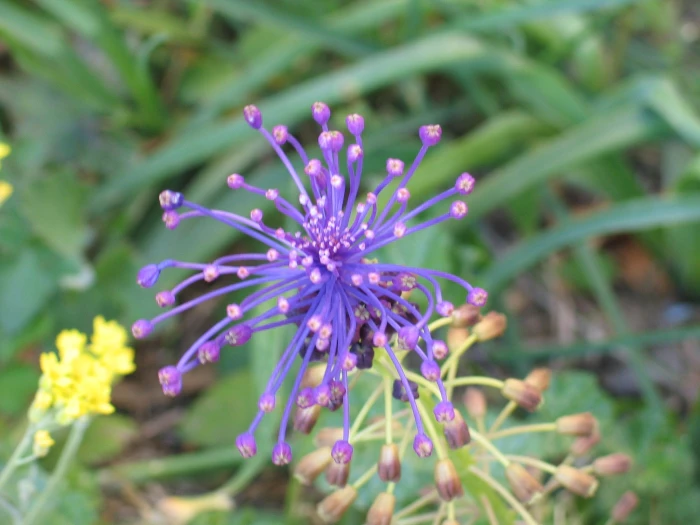Tassel Hyacinth
(Muscari comosum)
Tassel Hyacinth (Muscari comosum)
/
/

Flora_DUMO
CC BY 4.0
Image By:
Flora_DUMO
Recorded By:
Copyright:
CC BY 4.0
Copyright Notice:
Photo by: Flora_DUMO | License Type: CC BY 4.0 | License URL: http://creativecommons.org/licenses/by/4.0/ | Rights Holder: Flora_DUMO | Publisher: iNaturalist | Date Created: 2007-04-06T17:39:24-07:00 |
















Estimated Native Range
Climate Requirements for Westminster, Colorado
| This Plant | Your Site | Plant Suitability for Your Location | ||
|---|---|---|---|---|
| • Precipitation | 1" - 91" | 17" | Your precipitation may be insufficient for this plant. Irrigate N" / year. | Irrigate N" / year |
| • High Temp. | 50°F - 110°F | 89°F | Your summer temperatures are normal for this plant. | Excellent |
| • Low Temp. | 7°F - 59°F | 17°F | Your winter temperatures are normal for this plant | Excellent |
This plant should grow well at your location with about N inches per year (Y minutes per month) of irrigation.
Summary
Muscari comosum, commonly known as tassel hyacinth or tassel grape hyacinth, is a perennial bulbous plant native to grasslands, rocky slopes, and scrub areas in the Mediterranean region, including Southern Europe, North Africa, and parts of the Middle East. It has also naturalized in parts of the British Isles. This species typically grows to a height of 8-12 inches (20-30 centimeters) and features a unique inflorescence with a tuft of sterile bright blue flowers above a cluster of fertile brownish-green flowers, blooming in late spring to early summer. The flowers are quite showy and add a distinctive texture to garden displays.
Tassel hyacinth is valued for its ornamental qualities, particularly the unusual arrangement and color contrast of its flowers. It is often used in rock gardens, borders, and as underplanting for taller, deciduous shrubs. The bulbs are edible and considered a delicacy in southern Italy and Greece, where they are harvested and consumed in various traditional dishes. Cultivation requires well-drained soil, moderate watering, and full sun to part shade conditions. While generally low-maintenance, the plant can be susceptible to bulb rot if overwatered or planted in poorly drained soils. It is not known to have aggressive roots or significant disease problems, but it can self-seed and spread if conditions are favorable, which should be monitored to prevent unwanted naturalization.CC BY-SA 4.0
Tassel hyacinth is valued for its ornamental qualities, particularly the unusual arrangement and color contrast of its flowers. It is often used in rock gardens, borders, and as underplanting for taller, deciduous shrubs. The bulbs are edible and considered a delicacy in southern Italy and Greece, where they are harvested and consumed in various traditional dishes. Cultivation requires well-drained soil, moderate watering, and full sun to part shade conditions. While generally low-maintenance, the plant can be susceptible to bulb rot if overwatered or planted in poorly drained soils. It is not known to have aggressive roots or significant disease problems, but it can self-seed and spread if conditions are favorable, which should be monitored to prevent unwanted naturalization.CC BY-SA 4.0
Plant Description
- Plant Type: Herb, Bulb
- Height: 0.5-1.5 feet
- Width: 0.5-1 feet
- Growth Rate: Moderate
- Flower Color: Blue
- Flowering Season: Spring
- Leaf Retention: Deciduous
Growth Requirements
- Sun: Full Sun, Part Shade
- Water: Medium
- Drainage: Medium
Common Uses
Bee Garden, Border Plant, Butterfly Garden, Groundcover, Low Maintenance, Rock Garden
Natural Habitat
Native to grasslands, rocky slopes, and scrub areas in the Mediterranean region
Other Names
Common Names: Tassel Grape Hyacinth, Leopoldia comosa
Scientific Names: Muscari comosum, Bellevalia bouriana, Bellevalia bouriana, Bellevalia calandriniana, Bellevalia comosa, Bellevalia graeca, Bellevalia graminifolia, Bellevalia holzmannii, Bellevalia holzmannii var. curta
GBIF Accepted Name: Muscari comosum